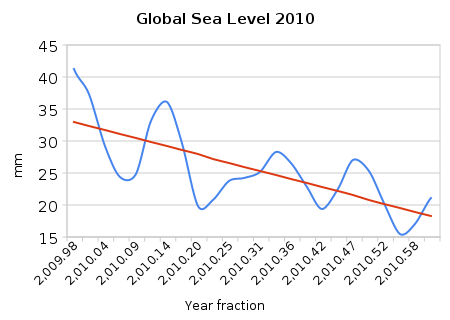The University of Colorado just updated their sea level data, and it now shows a drop of 15 mm since the end of last year. If that were to continue, sea level would fall close to 1.5 metres (5 feet) by the end of the century.
Obviously that isn’t going to happen. So what’s my point – Joe?
My point is that people keep saying it is the hottest year ever – and the Greenland and and Antarctic ice sheets are melting down and will wipe out coastal cities in a few decades.
But the data shows that isn’t true, and that you (Joe) are spreading misinformation. In order to reach Hansen’s 5 meters per century, sea level would have to rise over 50 mm this year, not fall 15 mm.



If that were to continue, sea level would fall close to 1.5 metres (5 feet) by the end of the century.
Obviously that isn’t going to happen
Dang. That would have meant bigger beaches to hold more girls in bikinis. ‘Obviously that isn’t going to happen’.
I can see you’re a “glass is half full” sort of guy.
For the doom n gloom, “glass is half empty” crowd, bigger beaches mean, what else, more beach erosion (gotta have some reason to cry into their beer).
But you’d need to take your binoculars to see them, because they’d be sooo far away. LOL.
LOL
Steve,
Would you be able to look at past few/several years, to see what the sea level trend is for the last three months of the year? Just curious what it shows (is it generally increasing, flat, or decreasing), and what that would projected for an end-of-year point. Even though we know it might change, just curious as to what it would show.
Poor Steve … yet another thing he can’t get his head around.
Non-linear forcast vs short term trend.
Didn’t learn much from the previous time you post this kind of rubbish did you Steve?
http://stevengoddard.wordpress.com/2010/10/01/sea-level-falling-in-2010/#comment-2303
So when Hansen forecast that Manhattan would be drowning in 2008, he meant a virtual 2008. One that can shift in his worshippers minds.
Your theory is that it will be almost flat for 50 years and then rise like six metres overnight. Brilliant.
As an observer of GW posts for more than a decade, it amazes me that the predictors of doom have any measure of credibility. Their only successful predicition is that atmospheric carbon dioxide is increasing.
For some time I’ve felt a Prediction Scoreboard is needed for people on both sides of the issue (as well as for politicians). We need to be reminded who can be trusted.
As to sea level rise over the last year, why is there a seasonal cycle?
The Earth is warmer during the Northern hemisphere summer.
Are you sure? I thought we were actually closer to the sun during the Northern hemisphere winter which might make the earth warmer.
There is more land in the Northern Hemisphere, so it heats up more during the summer.
Still think Dr. Pielke is on the right track. Ocean heat content is the metric that we need to look to.
Hmmm, why would the sealevel drop? Could it be heat release from the ocean? El Nino’s have to get their heat from the ocean giving it up (AFAIK), so I looked back at the data and eyeballing it you can see similar drops in the 1998 and 2003 el Nino years. 2006 and 1994 aren’t as obvious although it does look flat afterwards. Just an observation, don’t know if the correlation really holds. Also, temps in this century have been flat and the sea level rise has been flattening too.
Oh, and it looks like the sealevel change is about to fall outside of the IPCC prediction.
As well, cooling oceans will not only shrink, they will absorb more CO2. Any inkling of that in the current Mauna Loa records?